Wednesday, 4 March 2015: Civilization and the Citadel
Written 7 March 2015
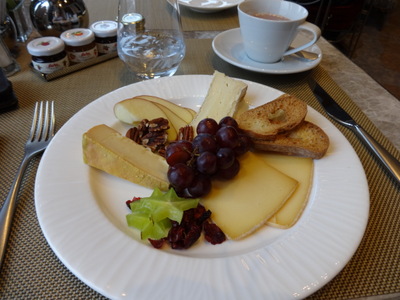
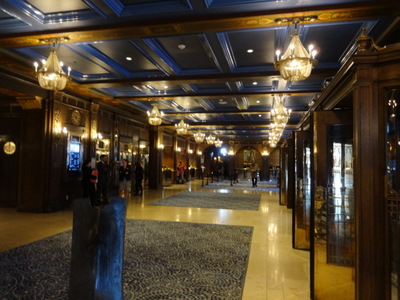 Wednesday morning, David stuck with the basket of pastries, but I ordered the cheese plate for breakfast. Once again, I couldn't get all the names, but the cheeses were very good, and the presentation was lovely. Clockwise from the top: Riopelle (the only cheese I got the name of, Brie-like); crisp toasts (a little too crisp, maybe), two slices of a semihard, washed-rind cheese, similar to Comté; dried cranberries and slices of carambola; a slightly softer semihard with a washed rind that had an odd greenish-yellow tint; pecans; apple slices. In the middle, grapes. Hot chocolate on the side.
Wednesday morning, David stuck with the basket of pastries, but I ordered the cheese plate for breakfast. Once again, I couldn't get all the names, but the cheeses were very good, and the presentation was lovely. Clockwise from the top: Riopelle (the only cheese I got the name of, Brie-like); crisp toasts (a little too crisp, maybe), two slices of a semihard, washed-rind cheese, similar to Comté; dried cranberries and slices of carambola; a slightly softer semihard with a washed rind that had an odd greenish-yellow tint; pecans; apple slices. In the middle, grapes. Hot chocolate on the side.
At the right, a view down the length of the hotel's lobby.
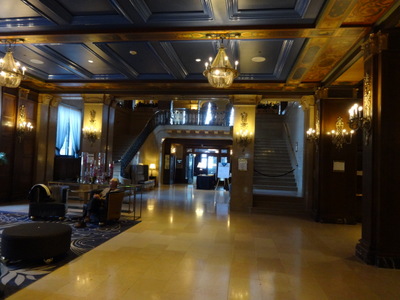
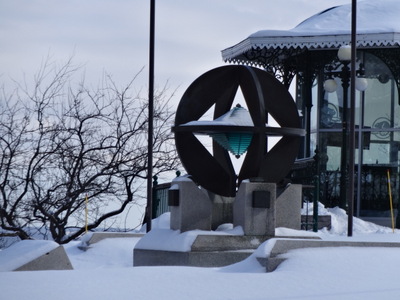 At the left here, a view along the length of the lobby, facing the other way. At the end is a room facing out over the Place d'Armes (the focal point of the walled city). The stairs on either side of it lead up one floor to the lobby of the conference center, where the meetings took place.
At the left here, a view along the length of the lobby, facing the other way. At the end is a room facing out over the Place d'Armes (the focal point of the walled city). The stairs on either side of it lead up one floor to the lobby of the conference center, where the meetings took place.
Our choice of museums was limited. Two of the major ones, the Naval Museum and the Museum of American Francophony (alas, those at the top of our list), were closed for renovation, so we set off for the Museum of Civilization, on the banks of river, below and downstream of the hotel. On our way to the stairway down the cliff, we passed this UNESCO monument, commemorating the designation of the city as a World Heritage Site.
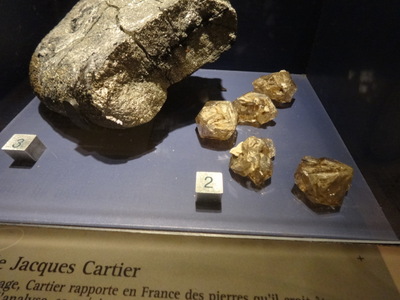
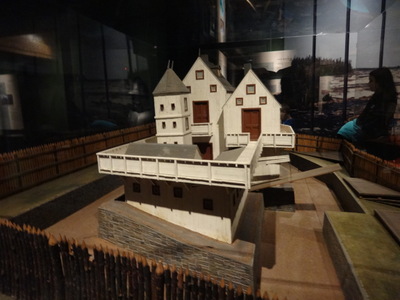 The Museum of Civilization turns out to be mostly a museum of the history of Quebec, although it was also featuring a large exhibit on cartooning and animation. Unfortunately, it's one of those museums where they discourage photography, so I don't have much to show of what we saw, but we spent most of our time working our way through a detailed time line of the history of the city and province.
The Museum of Civilization turns out to be mostly a museum of the history of Quebec, although it was also featuring a large exhibit on cartooning and animation. Unfortunately, it's one of those museums where they discourage photography, so I don't have much to show of what we saw, but we spent most of our time working our way through a detailed time line of the history of the city and province.
At the left are stones similar to those Jacques Cartier took back to France as "diamonds and gold"—actually quartz crystals and pyrite. At the right is a model of the "Abitation" (i.e., habitation; he apparently didn't spell well) that Samuel Champlain built on the river bank where he founded Quebec. It was basically a fur-trading post but defensible in case of attack.
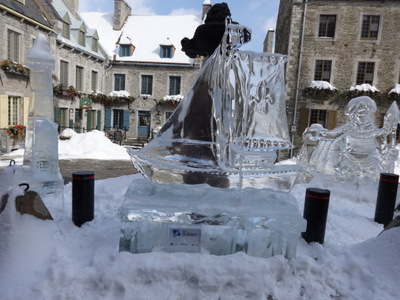
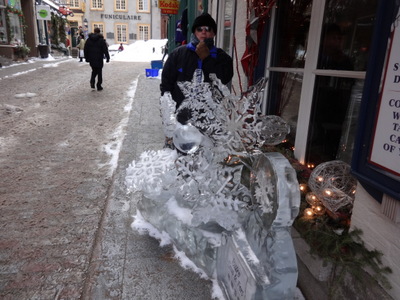 Because I have so few photos from the museum, I'll illustrate this section with shots of the ice sculptures we passed on the way to lunch afterward. Each restaurant had at least one out front and street corners and fountains tended to have several.
Because I have so few photos from the museum, I'll illustrate this section with shots of the ice sculptures we passed on the way to lunch afterward. Each restaurant had at least one out front and street corners and fountains tended to have several.
This week is spring break for the city's schools, so the museum was teeming with families with children. The smaller ones were pretty much spherical on arrival, before their parents extricated them from their down snowsuits, boots, and parkas. In any public institution around here, the cloakroom is a major operation, where you can deposit not just coats, scarves, and hats but backpacks, boots, and probably snowshoes and skis!
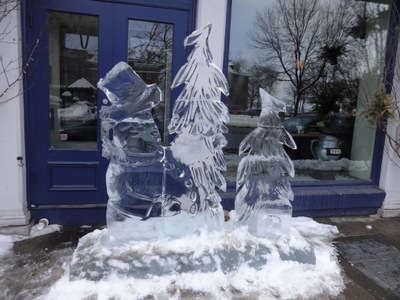
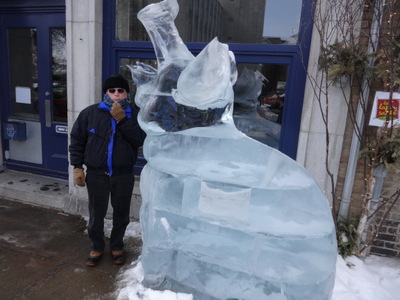 A large section of the museum was dedicated to "the conquest"—the fall of the French city (and therefore province) to the British, just before the American revolution. Like that of the American Civil War, the aftermath of the conflict still simmers below the surface, and a video montage of man-on-the-street interviews revealed that some still consider it the worst thing that ever happened to the city and others think it's the best. The ascerbic reply of a Native American woman was, "And just which conquest are we talking about?"
A large section of the museum was dedicated to "the conquest"—the fall of the French city (and therefore province) to the British, just before the American revolution. Like that of the American Civil War, the aftermath of the conflict still simmers below the surface, and a video montage of man-on-the-street interviews revealed that some still consider it the worst thing that ever happened to the city and others think it's the best. The ascerbic reply of a Native American woman was, "And just which conquest are we talking about?"
The mnemonic I've developed is that the Quebec area became French just before the Pilgrims, became British just before the Revolution, and became Canada just before the Civil War. By the time we left the museum, it was snowing again.
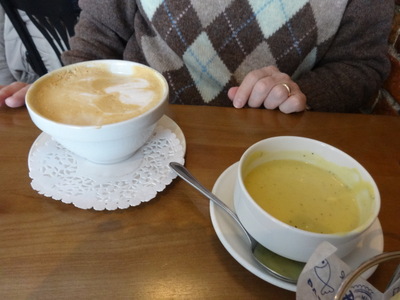
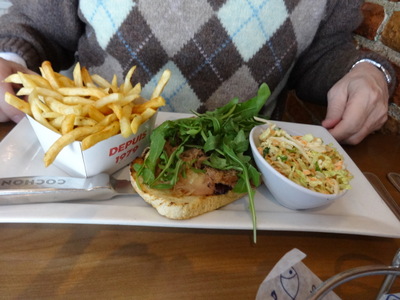 The last ice sculpture I show, the one David is standing next to (and he really is right next to it; it really is that big), is the one outside Le Cochon Dingue (the Crazy Pig), the restaurant where we had lunch. It came highly recommended by the meeting organizers as both good and inexpensive, and they were right.
The last ice sculpture I show, the one David is standing next to (and he really is right next to it; it really is that big), is the one outside Le Cochon Dingue (the Crazy Pig), the restaurant where we had lunch. It came highly recommended by the meeting organizers as both good and inexpensive, and they were right.
At the left is David's first course—he ordered the plat du jour, not realizing it came with soup, sides, and dessert. The soup, at the right in the photo, was purée of cauliflower with curry. With it, he ordered a café au lait, which was served as is traditional, in a bowl without a handle.
At the right is his main course, a tartine of duck confit—a slice of toasted country bread thickly spread with shredded duck mixed with chunks of stewed apple and topped with arugula. On the side, excellent coleslaw and pretty good fries.
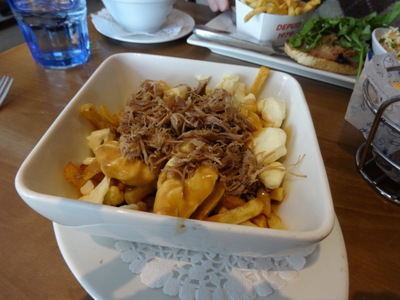
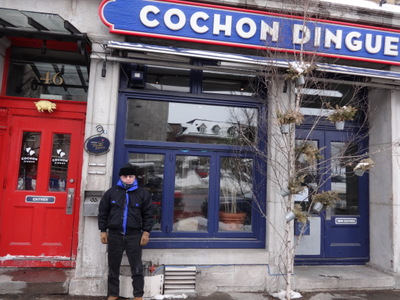 At the left here is my lunch—"poutine coin coin" (in French, ducks say not "quack quack" but "coin coin"). Your basic poutine is a bowl of fries topped with cheese curds and brown gravy, and to make it "coin coin," they added shredded duck confit on top. Yummy.
At the left here is my lunch—"poutine coin coin" (in French, ducks say not "quack quack" but "coin coin"). Your basic poutine is a bowl of fries topped with cheese curds and brown gravy, and to make it "coin coin," they added shredded duck confit on top. Yummy.
At the right is the restaurant façade, with David for scale. The ice pig is just out of the frame to the right.
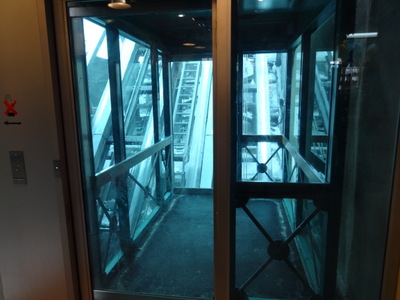
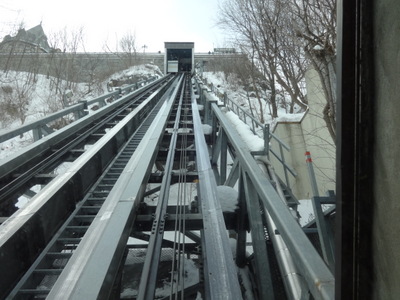 Rather than climb back up all those stairs to reach the hotel (and the route to our next stop), we took the funicular ($2.25 each).
Rather than climb back up all those stairs to reach the hotel (and the route to our next stop), we took the funicular ($2.25 each).
At the left is the view into the empty car as we entered; at the right, a view up the tracks to the station at the top. A little of our hotel is visible at the top left.
The ride is very short but very scenic, thanks to the car's all-glass construction.
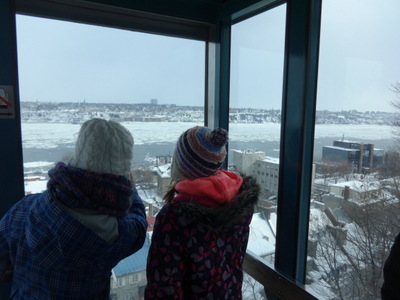
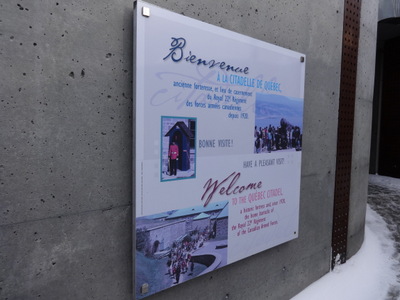 At the left here is the view from near the top, back out over the river. We are reliably informed that a fleet of seven ice breakers work all winter to keep the river open all the way to Toronto. In season, they take turns going up north to open ports on Hudson's Bay.
At the left here is the view from near the top, back out over the river. We are reliably informed that a fleet of seven ice breakers work all winter to keep the river open all the way to Toronto. In season, they take turns going up north to open ports on Hudson's Bay.
From the funicular, we walked directly to the Citadel of Quebec, hoping to take the guided tour. Unfortunately, the guided portion turned out to be an hour long and mostly outdoors, so we passed on that and just spent time in the indoor museum, which again did not allow photography. The photo at the right is the sign welcoming us at the citadel's entrance.
The citadel is the home base of the Royal 22nd Regiment, the original (and perhaps still only) French-speaking unit in the Canadian military. Their nickname is the "Van Doos," which is apparently as close as the local anglophones could come to saying "vingt-deux," twenty-two, back when the unit was formed, just before WWI.
I was very impressed with what we learned about the 22nd. For example, they were at Vimy, Ypres, Passchendaele, and the battle of the Somme! Later, they came back to Canada and dominated their ice-hockey league, which I can well believe—take a hockey stick and go up against the guys who took Vimy Ridge?! Yikes!
The museum includes a whole room that just displays the medals of the unit's most decorated members—really impressive.
The temporary exhibit was also very striking. Someone had chosen pairs of photos of the 22nd, one from WWI and the other from the recent war in Afghanistan, showing striking parallels in the two situations—standing in front of ruined buildings, wrestling big guns into position, a soldier muffled against gas in one photo and against dust and sand in the other. The only pair that struck me as not really parallel included photos of soldiers looking out across barren landscapes toward billows of smoke in the old photo and wind-blown sand in the recent one. The Afghan landscape was clearly barren desert even before the conflict, whereas the landscape in the early photo was barren only because it had been bombed to a pulp.
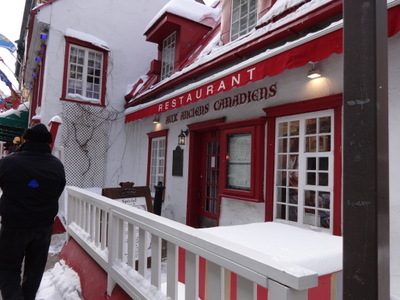
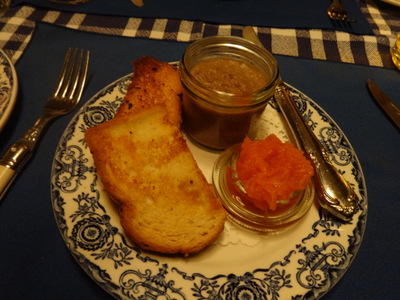 After heading back to the hotel to rest our feet for a few minutes, we dropped by the registration/ icebreaker gathering to pick up nametags and David's registration materials, then rendezvoused for dinner with our friend John Hamilton at a nearby restaurant, Aux Anciens Canadiens, which specializes in game and occupies the oldest house still standing in Old Quebec.
After heading back to the hotel to rest our feet for a few minutes, we dropped by the registration/ icebreaker gathering to pick up nametags and David's registration materials, then rendezvoused for dinner with our friend John Hamilton at a nearby restaurant, Aux Anciens Canadiens, which specializes in game and occupies the oldest house still standing in Old Quebec.
John and I ordered the "discovery menu," consisting of appetizer, main course, and dessert. David wasn't very hungry, so he ordered just a main course with mushrooms on the side. Unfortunately, the waitress misunderstood and served him the whole "table d'hôte" nine yards to accompany his main course, so he got appetizer, main course with two sides, plus the mushrooms, and dessert!
At the right is the appetizer David and I got—rillettes de cerf (venison spread). The meat was pulverized (not chopped or ground) with a little fat and broth to make a spreadable paste and was served with toasts and a little dish of carrot jam that was surprisingly good with the venison. A quarter pound of pretty much solid meat was a little heavy as an appetizer, but it was really good!
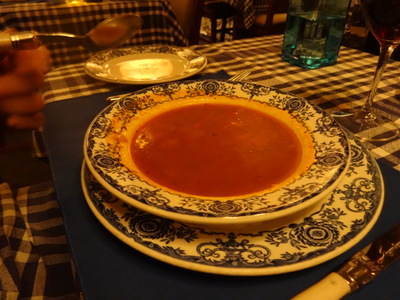
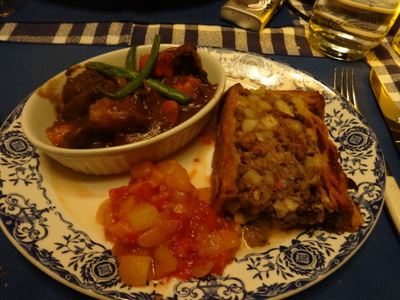 John started with the soup of the day, which was vegetable and which he declared excellent.
John started with the soup of the day, which was vegetable and which he declared excellent.
At the right is John's and my main course—the "Coureur des bois" (translated "Trapper's treat"), consisting of a slab of "tourtière du Lac Saint-Jean" (a meat pie) and a dish of bison pot roast with green beans, carrots, and potatoes, all accompanied by a "fruit ketchup" (tomatoes, apples, etc. stewed together with sugar and vinegar). Wow. The bison was good, but the meat pie was outstanding! I've found a couple of recipes for it on line; I'm going to have to try that at home.
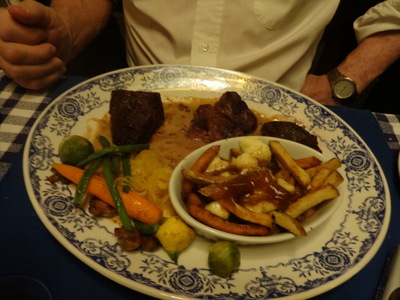
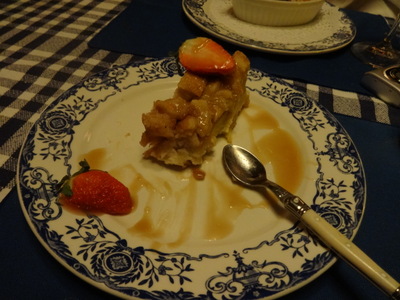 At the left here is David's main course. He ordered "les trois mignons"—filet mignons of (right to left in the photo) venison, wapiti (American elk), and bison. With them, he got a dish of poutine and a vegetable medley that included whole baby squash, green beans, carrots, mushrooms, and brussels sprouts. The mushroom side dish came plated separately. He let me taste the venison, and it was great!
At the left here is David's main course. He ordered "les trois mignons"—filet mignons of (right to left in the photo) venison, wapiti (American elk), and bison. With them, he got a dish of poutine and a vegetable medley that included whole baby squash, green beans, carrots, mushrooms, and brussels sprouts. The mushroom side dish came plated separately. He let me taste the venison, and it was great!
At the right is my dessert, bread pudding with maple caramel sauce. Good but a little dense.
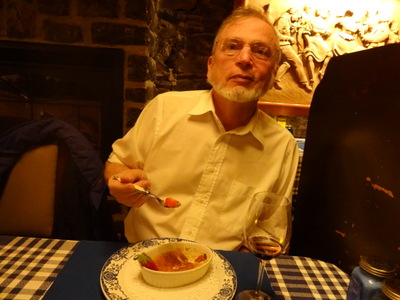
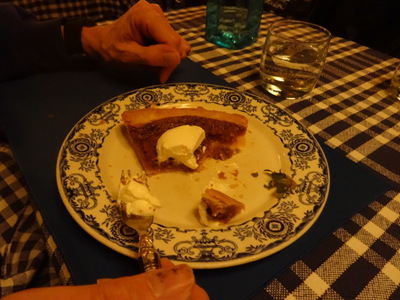 At the left here is David enjoying his maple crême brulée.
At the left here is David enjoying his maple crême brulée.
John was intrigued by the "maple syrup pie" and had to try that. It turned out to be a maple chess pie, i.e., like a pecan pie without the pecans, and with maple sugar replacing the white sugar. Good, he said, but very sweet.
On the back of the menu, I read the history of the building in which the restaurant is located. It's apparently the oldest house still standing in the city, and at one point it was occupied by Philippe Aubert de Gaspé (the elder), who wrote a classic called Les Anciens Canadians, which I have since downloaded to my Kindle from Gutenberg.org. Hence the name of the restaurant.
previous entry
List of Entries
next entry

 Wednesday morning, David stuck with the basket of pastries, but I ordered the cheese plate for breakfast. Once again, I couldn't get all the names, but the cheeses were very good, and the presentation was lovely. Clockwise from the top: Riopelle (the only cheese I got the name of, Brie-like); crisp toasts (a little too crisp, maybe), two slices of a semihard, washed-rind cheese, similar to Comté; dried cranberries and slices of carambola; a slightly softer semihard with a washed rind that had an odd greenish-yellow tint; pecans; apple slices. In the middle, grapes. Hot chocolate on the side.
Wednesday morning, David stuck with the basket of pastries, but I ordered the cheese plate for breakfast. Once again, I couldn't get all the names, but the cheeses were very good, and the presentation was lovely. Clockwise from the top: Riopelle (the only cheese I got the name of, Brie-like); crisp toasts (a little too crisp, maybe), two slices of a semihard, washed-rind cheese, similar to Comté; dried cranberries and slices of carambola; a slightly softer semihard with a washed rind that had an odd greenish-yellow tint; pecans; apple slices. In the middle, grapes. Hot chocolate on the side.
 At the left here, a view along the length of the lobby, facing the other way. At the end is a room facing out over the Place d'Armes (the focal point of the walled city). The stairs on either side of it lead up one floor to the lobby of the conference center, where the meetings took place.
At the left here, a view along the length of the lobby, facing the other way. At the end is a room facing out over the Place d'Armes (the focal point of the walled city). The stairs on either side of it lead up one floor to the lobby of the conference center, where the meetings took place.
 The Museum of Civilization turns out to be mostly a museum of the history of Quebec, although it was also featuring a large exhibit on cartooning and animation. Unfortunately, it's one of those museums where they discourage photography, so I don't have much to show of what we saw, but we spent most of our time working our way through a detailed time line of the history of the city and province.
The Museum of Civilization turns out to be mostly a museum of the history of Quebec, although it was also featuring a large exhibit on cartooning and animation. Unfortunately, it's one of those museums where they discourage photography, so I don't have much to show of what we saw, but we spent most of our time working our way through a detailed time line of the history of the city and province. 
 Because I have so few photos from the museum, I'll illustrate this section with shots of the ice sculptures we passed on the way to lunch afterward. Each restaurant had at least one out front and street corners and fountains tended to have several.
Because I have so few photos from the museum, I'll illustrate this section with shots of the ice sculptures we passed on the way to lunch afterward. Each restaurant had at least one out front and street corners and fountains tended to have several.
 A large section of the museum was dedicated to "the conquest"—the fall of the French city (and therefore province) to the British, just before the American revolution. Like that of the American Civil War, the aftermath of the conflict still simmers below the surface, and a video montage of man-on-the-street interviews revealed that some still consider it the worst thing that ever happened to the city and others think it's the best. The ascerbic reply of a Native American woman was, "And just which conquest are we talking about?"
A large section of the museum was dedicated to "the conquest"—the fall of the French city (and therefore province) to the British, just before the American revolution. Like that of the American Civil War, the aftermath of the conflict still simmers below the surface, and a video montage of man-on-the-street interviews revealed that some still consider it the worst thing that ever happened to the city and others think it's the best. The ascerbic reply of a Native American woman was, "And just which conquest are we talking about?"
 The last ice sculpture I show, the one David is standing next to (and he really is right next to it; it really is that big), is the one outside Le Cochon Dingue (the Crazy Pig), the restaurant where we had lunch. It came highly recommended by the meeting organizers as both good and inexpensive, and they were right.
The last ice sculpture I show, the one David is standing next to (and he really is right next to it; it really is that big), is the one outside Le Cochon Dingue (the Crazy Pig), the restaurant where we had lunch. It came highly recommended by the meeting organizers as both good and inexpensive, and they were right.
 At the left here is my lunch—"poutine coin coin" (in French, ducks say not "quack quack" but "coin coin"). Your basic poutine is a bowl of fries topped with cheese curds and brown gravy, and to make it "coin coin," they added shredded duck confit on top. Yummy.
At the left here is my lunch—"poutine coin coin" (in French, ducks say not "quack quack" but "coin coin"). Your basic poutine is a bowl of fries topped with cheese curds and brown gravy, and to make it "coin coin," they added shredded duck confit on top. Yummy.
 Rather than climb back up all those stairs to reach the hotel (and the route to our next stop), we took the funicular ($2.25 each).
Rather than climb back up all those stairs to reach the hotel (and the route to our next stop), we took the funicular ($2.25 each).
 At the left here is the view from near the top, back out over the river. We are reliably informed that a fleet of seven ice breakers work all winter to keep the river open all the way to Toronto. In season, they take turns going up north to open ports on Hudson's Bay.
At the left here is the view from near the top, back out over the river. We are reliably informed that a fleet of seven ice breakers work all winter to keep the river open all the way to Toronto. In season, they take turns going up north to open ports on Hudson's Bay.
 After heading back to the hotel to rest our feet for a few minutes, we dropped by the registration/ icebreaker gathering to pick up nametags and David's registration materials, then rendezvoused for dinner with our friend John Hamilton at a nearby restaurant, Aux Anciens Canadiens, which specializes in game and occupies the oldest house still standing in Old Quebec.
After heading back to the hotel to rest our feet for a few minutes, we dropped by the registration/ icebreaker gathering to pick up nametags and David's registration materials, then rendezvoused for dinner with our friend John Hamilton at a nearby restaurant, Aux Anciens Canadiens, which specializes in game and occupies the oldest house still standing in Old Quebec.
 John started with the soup of the day, which was vegetable and which he declared excellent.
John started with the soup of the day, which was vegetable and which he declared excellent.
 At the left here is David's main course. He ordered "les trois mignons"—filet mignons of (right to left in the photo) venison, wapiti (American elk), and bison. With them, he got a dish of poutine and a vegetable medley that included whole baby squash, green beans, carrots, mushrooms, and brussels sprouts. The mushroom side dish came plated separately. He let me taste the venison, and it was great!
At the left here is David's main course. He ordered "les trois mignons"—filet mignons of (right to left in the photo) venison, wapiti (American elk), and bison. With them, he got a dish of poutine and a vegetable medley that included whole baby squash, green beans, carrots, mushrooms, and brussels sprouts. The mushroom side dish came plated separately. He let me taste the venison, and it was great!
 At the left here is David enjoying his maple crême brulée.
At the left here is David enjoying his maple crême brulée.